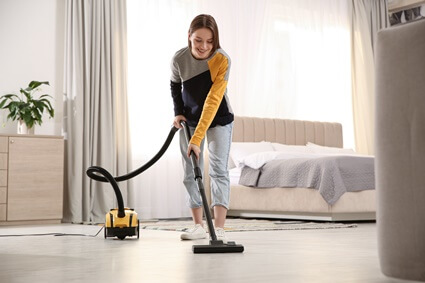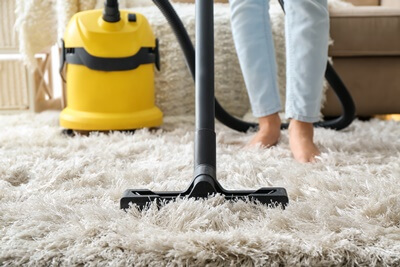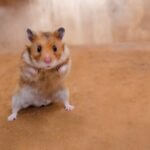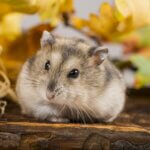Last Updated on: 4th January 2024, 08:01 pm
Vacuuming is essential to home cleanliness, especially if you own a pet. Hamsters throw poop, food, and bedding out of their cage while they explore and play.
So, you can expect to vacuum the area around a hamster’s cage frequently. The problem is that a vacuum cleaner’s size, motion, and whirring noise could scare a hamster.
Do Hoovers Scare Hamsters?
Vacuum cleaners (hoovers) may scare a hamster, depending on its life experiences and personality.
Some will be terrified by the sound and won’t calm down until it ends. Others will be initially startled by the vacuum before eventually recognizing that it’s harmless.
The best approach is to observe the hamster’s reaction and adjust your vacuuming routine.
When hamsters are upset by vacuums, it’s because of the loud noise produced when activated. Worse still, this noise begins abruptly, which means the sudden volume can frighten a hamster.
Such noise doesn’t exist in a hamster’s natural environment, so it’ll be unsettling. As prey animals, hamsters are instinctively driven to run away from frightening noises.
These sounds indicate a predator running toward them or pushing through obstacles to attack them. They can also signal natural phenomena, like storms (thunder and lightning).
So, using the vacuum in the same room as a hamster can lead to it running for safety.
However, other hamsters (especially those raised in captivity) grow used to loud and strange noises produced in human environments. The sounds of traffic, TV, radio, other pets, and human activities become normal to them, and hamsters learn to ignore the sounds.
Additionally, hamsters rely on their sense of smell to detect danger, which is why a dog’s bark may be more frightening than the roar of a vacuum.
The hamster can smell the pheromones of a large predator in addition to the sound. Meanwhile, the vacuum smells different, but the hamster has no natural frame of reference to judge it by.
So, an older hamster that has bonded with you is less likely to get scared. However, if the hamster is already distrusting and skittish, it may dread the sound of a vacuum.
How To Tell If A Hamster Hates The Vacuum
Depending on how long the vacuuming session lasts, a hamster can show signs of stress, including:
Hyperactivity
If a hamster has an active personality, it may go into overdrive when frightened and appear restless. It may run on its wheel or frantically pace, dig, and climb in its cage.
Unusual Behavior
The perceived sense of danger may trigger the hamster to act weirdly, produce unusual noises, or engage in repetitive actions, like:
- Gnawing on the cage bars.
- Banging its head on the wall.
- Turning on its back.
These actions are an indication that the hamster is scared or upset.
Aggression
Depending on how the hamster views the threat from the vacuum, it may become aggressive.
It’ll start screaming or hissing as it shows its teeth, with its ears slanted backward. This indicates that the hamster is stressed and sufficiently fearful of the danger that it has decided to fight back.
Withdrawal
Some hamsters are inherently timid and will withdraw into a corner and hide until the noise is gone. If there are other loud noises, it’ll stay hidden and refuse to come out to eat or play until it feels safe again.

Should I Avoid Vacuuming Around A Hamster?
If you notice the above signs during or after vacuuming, avoid using them around the hamster. You can move the hamster’s cage to a different room to clean the area.
Don’t ignore the hamster’s distress, as unmanaged stress can lead to severe illness or even death. A stressed hamster won’t eat, which will affect its immune system.
The MSD Veterinary Manual said that diseases like wet-tail (proliferative ileitis) are often caused by stress.
Can You Vacuum Near a Hamster?
However, it’s not impossible to vacuum in a hamster’s presence. Teach the hamster to recognize the sound as foreign but harmless. To accomplish this, ensure the hamster detects your presence and that the cleaning process doesn’t last more than 30 minutes.
By feeling your presence, the hamster will relax, knowing its owner is at hand to protect it from danger. Keeping the length of the noise disruption to the minimum will also ensure that you don’t hurt its ears.
According to Hearing Research, hamsters can discern sounds well below 100 Hz. Furthermore, hamsters rely heavily on their sense of hearing because they have poor eyesight.
The Journal of the American Association of Laboratory Animal Science found that mice are similar to hamsters due to their supersonic hearing range.
The rodents in the study were exposed to 1 hour of loud vacuum cleaner noise, and tests were carried out at varying time frames after the exposure.
The mice didn’t exhibit any changes in acute stress response compared to those in the control group. This means the vacuum noise wasn’t loud enough to spook them.
However, some hamsters are easily frightened by loud noises and will express their displeasure. Depending on their personality type, some hamsters may become aggressive when you turn the vacuum on, while timid hamsters hide in a corner.
How To Hoover Around Hamsters
A hamster will likely stop being stressed and afraid if it grows accustomed to the sound of a hoover. To help it adjust to the sound, you should make the following adjustments:
Well-Lit Room
Ensure the hamster can see you and the vacuum throughout your cleaning session. That way, it’ll stop thinking there’s a big, loud predator in the room.
Have Someone Turn the Hoover on in Another Room
Go into the hamster’s room and start playing with it as the vacuum runs in a different room. Give the hamster treats to help it relax and show that the noise doesn’t make it unsafe.
Monitor the Hamster’s Reactions
If the vacuum sound doesn’t make the hamster panic, tell the other person to move it closer. Meanwhile, keep feeding the hamster occasional treats.
Continue this process until you bring the vacuum inside the room.
Put some hideouts in the cage so the hamster can hide whenever it feels unsafe. It’ll be less stressed about the encroaching sound once it knows it has an emergency hiding place.
Keep the Hoover Away from The Hamster
When vacuuming, separate the hamster and vacuum by at least 4 feet to provide a sense of safety.
Ideally, the hamster will be in its cage and not free-roaming on the ground, allowing it to feel safe in its home rather than be chased by the loud machine.
Even if the hamster is in its cage, don’t vacuum directly next to it.
At that distance, the noise of the vacuum might be harmful. Instead, clean the rest of the room and move the cage to the opposite side when you need to clean that corner.
Silent Hoover
Many brands of hoovers have sound levels as low as 64 dB. Since everyday human conversations produce about 60dB, a 64dB hoover will rarely bother a hamster.





